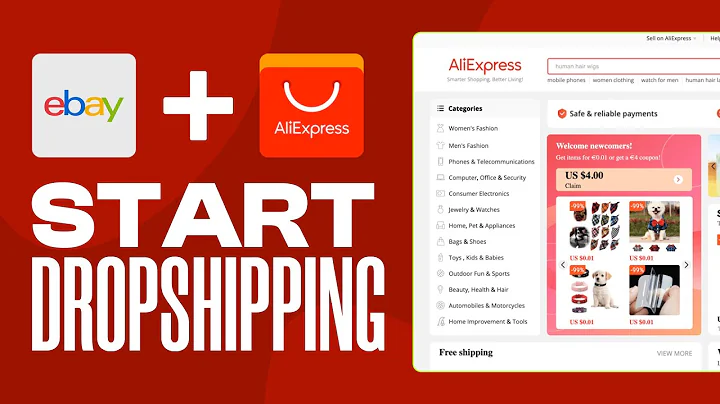Start a Profitable Dropshipping Business in Nigeria with Your Smartphone
Table of Contents:
- Introduction
- What is dropshipping
- Finding Reliable Suppliers
3.1 Online Suppliers
3.2 Offline Suppliers
- How to Make Money as a Dropshipper
4.1 Choosing Products
4.2 Setting Prices
4.3 Posting on Social Media Platforms
4.4 Managing Orders
4.5 Shipping and Logistics
- Advantages of Dropshipping
- Disadvantages of Dropshipping
- Conclusion
Dropshipping: How to Start a Profitable Business with Zero Capital
Introduction:
Are you looking to start a business but lack the necessary capital? In this video, I will share with you a profitable online business model that requires zero capital investment. Dropshipping is a business concept that allows you to sell products without needing to keep inventory or invest in upfront costs. In this article, I will provide you with a comprehensive guide on how to start a dropshipping business and make a profit of 50,000 naira every other week.
1. What is Dropshipping
Dropshipping is an online business model that enables you to sell products without keeping them in stock. Instead of purchasing inventory upfront, you partner with suppliers who will fulfill orders on your behalf. As a dropshipper, you select the products you want to sell and promote them on various platforms. When a customer makes a purchase, you forward the order details to your supplier, who will then ship the product directly to the customer. Your profit comes from the difference between the price at which you sell the product and the price at which your supplier charges you.
2. Finding Reliable Suppliers
To ensure the success of your dropshipping business, it is crucial to find reliable and trusted suppliers. Both online and offline options are available for sourcing suppliers.
3.1 Online Suppliers:
You can search for suppliers online by using social media platforms such as Instagram and Facebook. Look for vendors who sell products within your chosen niche and reach out to them to discuss potential collaboration. Additionally, websites like gg.ng provide directories of suppliers from various industries. When contacting suppliers, make them aware that you are a dropshipper and explain your business model. It is important to establish clear communication and build a relationship based on trust.
3.2 Offline Suppliers:
If you prefer sourcing suppliers offline, you can visit major markets that specialize in the products you want to dropship. Approach store owners or distributors and explain your dropshipping business. Make it clear that you have an online presence and that you would like to promote their products. In some cases, you may need to educate them about dropshipping as they may not be familiar with the concept. Build rapport and negotiate terms that work for both parties.
4. How to Make Money as a Dropshipper
4.1 Choosing Products:
Before you start dropshipping, it is essential to select the right products to sell. Research trending products within your niche and consider factors such as quality, demand, and competition. Focus on products that have a potential market and can provide a reasonable profit margin.
4.2 Setting Prices:
As a dropshipper, you have control over the pricing of the products you sell. Since you add your profit to the supplier's price, it is important to determine a competitive yet profitable markup. Be cautious not to overprice your products, as this can drive potential customers away. Consider factors like market demand and your target audience's buying power when setting your prices.
4.3 Posting on Social Media Platforms:
Utilize social media platforms such as Facebook, Instagram, and WhatsApp to reach your target audience. Create business pages and catalogs to showcase your products. Regularly post high-quality images, descriptions, and prices to attract potential buyers. You can also create WhatsApp groups and run Facebook ads to generate more leads.
4.4 Managing Orders:
When a customer places an order, collect their details and payment. Ensure that you have a smooth process in place to track and manage all orders efficiently. Communicate with your supplier and provide them with the necessary information for order fulfillment, including the customer's details and shipping address.
4.5 Shipping and Logistics:
Work closely with your supplier to coordinate shipping and logistics. Specify how you want the products to be packaged and labeled. Discuss shipping fees and arrange for prompt delivery to your customer. Providing excellent customer service and ensuring timely delivery will help build trust and retain customers.
5. Advantages of Dropshipping
- Start with zero capital: Dropshipping allows you to start a business without the need for upfront inventory investment.
- Flexibility: You can operate your dropshipping business from anywhere, making it suitable for students, stay-at-home parents, or those with a 9-to-5 job.
- No inventory management: Unlike traditional businesses, dropshipping eliminates the need for inventory storage and management.
- Minimal shipping responsibilities: The supplier takes care of the packaging and shipping, allowing you to focus on marketing and sales.
6. Disadvantages of Dropshipping
- Dependence on suppliers: Success in dropshipping heavily relies on having trustworthy and reliable suppliers. A poor supplier can lead to delays, product quality issues, or even order cancellations.
- Lack of control over shipping and packaging: Since the supplier handles shipping and packaging, you must clearly communicate your requirements to ensure customer satisfaction.
- Potential competition: Dropshipping is a popular business model, and competition among dropshippers exists. It is important to find your unique selling point and effectively market your products.
7. Conclusion
Dropshipping offers a low-entry barrier to starting an online business and has the potential to generate a steady income. By finding reliable suppliers, selecting profitable products, and employing effective marketing strategies, you can build a successful dropshipping business. While there are some challenges, the advantages outweigh the disadvantages. With dedication and smart decision-making, you can create a profitable business with zero capital investment.
Highlights:
- Start a profitable online business with zero capital using the dropshipping model.
- Choose reliable suppliers both online and offline for successful order fulfillment.
- Set competitive prices to attract customers while ensuring a reasonable profit margin.
- Leverage social media platforms to promote your products and engage with potential customers.
- Streamline the order management process to ensure efficient communication with suppliers and timely delivery to customers.
- Take advantage of the flexibility and low overhead costs offered by dropshipping.
- Be aware of potential challenges such as dependence on suppliers and competition, but remember that the benefits outweigh the drawbacks.
FAQs:
Q: Can anyone start a dropshipping business?
A: Yes, dropshipping is a flexible business model that can be started by anyone, regardless of their background or experience. It is suitable for students, stay-at-home parents, and those with full-time jobs.
Q: Do I need to invest in inventory for a dropshipping business?
A: No, the beauty of dropshipping is that you don't need to invest in inventory upfront. You only purchase the product from the supplier after the customer makes a purchase from your store.
Q: How do I find reliable suppliers for my dropshipping business?
A: You can find suppliers online through platforms like Instagram, Facebook, and websites like gg.ng. Offline, you can approach store owners or distributors in major markets where your chosen products are available.
Q: How do I set the prices for my dropshipping products?
A: When setting prices, consider the cost of the product from the supplier, shipping fees, and your desired profit margin. Research the market and competition to ensure your prices are competitive.
Q: What are the advantages of dropshipping?
A: Some advantages include low entry costs, flexibility in running the business, no inventory management, and minimal shipping responsibilities.
Q: Are there any disadvantages to dropshipping?
A: Some disadvantages include reliance on suppliers, lack of control over the shipping process, and competition among dropshippers. However, with careful supplier selection and effective marketing strategies, these challenges can be overcome.



















